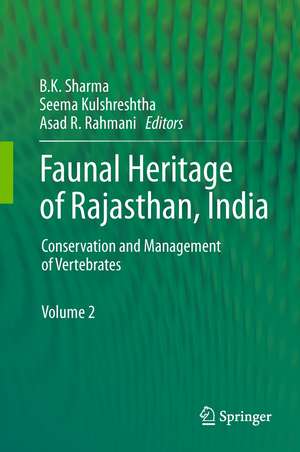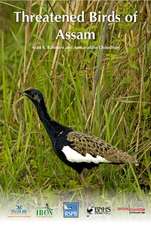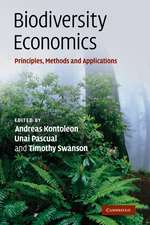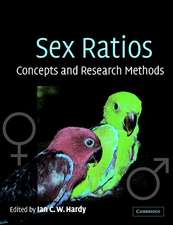Faunal Heritage of Rajasthan, India: Conservation and Management of Vertebrates
Editat de B.K. Sharma, Seema Kulshreshtha, Asad R. Rahmanien Limba Engleză Hardback – 24 oct 2013
| Toate formatele și edițiile | Preț | Express |
|---|---|---|
| Paperback (2) | 1229.28 lei 6-8 săpt. | |
| Springer International Publishing – 27 aug 2016 | 1229.28 lei 6-8 săpt. | |
| Springer – 23 aug 2016 | 1235.08 lei 6-8 săpt. | |
| Hardback (2) | 1235.43 lei 6-8 săpt. | |
| Springer International Publishing – 24 oct 2013 | 1235.43 lei 6-8 săpt. | |
| Springer – 14 sep 2013 | 1239.37 lei 6-8 săpt. |
Preț: 1235.43 lei
Preț vechi: 1506.62 lei
-18% Nou
Puncte Express: 1853
Preț estimativ în valută:
236.47€ • 256.95$ • 198.77£
236.47€ • 256.95$ • 198.77£
Carte tipărită la comandă
Livrare economică 21 aprilie-05 mai
Preluare comenzi: 021 569.72.76
Specificații
ISBN-13: 9783319013442
ISBN-10: 3319013440
Pagini: 560
Ilustrații: XXXI, 525 p. 208 illus., 184 illus. in color.
Dimensiuni: 155 x 235 x 34 mm
Greutate: 0.95 kg
Ediția:2013
Editura: Springer International Publishing
Colecția Springer
Locul publicării:Cham, Switzerland
ISBN-10: 3319013440
Pagini: 560
Ilustrații: XXXI, 525 p. 208 illus., 184 illus. in color.
Dimensiuni: 155 x 235 x 34 mm
Greutate: 0.95 kg
Ediția:2013
Editura: Springer International Publishing
Colecția Springer
Locul publicării:Cham, Switzerland
Public țintă
GraduateCuprins
Part I. Faunal Conservation as a Pragmatic Approach: Aspects and Challenges.- In Situ and Ex Situ Conservation: Protected Area network and Zoos of Rajasthan.- 2. Climate and Other Environmental Factors influencing Faunal Ecology of Rajasthan.- 3. Impact of altered Land Use Pattern on Small Mammalian Diversity of Hilly Tracts of Rajasthan, India.- 4. Threats to Faunal Diversity of the Aravalli Hills with Special Reference to Kumbhalgarh Wildlife Sanctuary.- 5. Faunal Ecology and Conservation of the Great Indian Desert.- 6. Planning Conservation for Chambal River Basin taking Gharial Gavialis gangeticus and Ganges River Dolphin Platanista gangetica as Umbrella Species.- 7. Reintroduction of Tigers in Sariska Tiger Reserve, Rajasthan.- 8. The Ramsar Sites of Rajasthan: Ecology and Conservation of Sambhar Salt Lake, Jaipur and Keoladeo National Park, Bharatpur.- 9. Impact of Mass Mortility of Gharial Gavialis gangeticus (Gmelin, 1789) on its Conservation in the Chambal River in Rajasthan.-10. Conservation and Management of Wetland Birds in Rajasthan: Perspectives and Challenges.- 11. Conservation and Management of Demoiselle Crane Anthropoides virgo at Kheechan in Rajasthan.- 12. Distribution of Sarus Crane Grus antigone in Rajasthan and People's Participation in the Protection of its Breeding Site.- 13. Conservation Prospects of Smooth-coated Otter Lutrogale perspicillata (Geoffroy Saint-Hilaire, 1826) in Rajasthan.- 14. Role of Local People and Community Conservation in Rajasthan.- 15. The Revial Model for Common Property Reserves in the Thar Desert of Rajasthan with Special Reference to their Faunal Components.- 16. Resource Dependency and Socio-economic Profile of Local Communities in Sariska Tiger Reserve, Rajasthan.- 17. Nature Reverence Does Not Mean Conservation in Tribal Rajasthan: Culture, Cognition, and Personal and Collective Commitments to the Environment.- Part II. Ecological and Wildlife Tourism in Rajasthan: The Terra Incognita.- 18. Ecotourism in Rajasthan: Prospects and Perspectives.- Part III. Vanguards of Wilderness.- 19. Wildlife Conservation in Rajasthan: The Legal Framework versus the Wildlife Trade.- Part IV. Management of Faunal Conservation in Rajasthan: A Synthesis.- 20. Unfurling Conservation Strategies, Major Initiatives, and Gaps in Research: A Vision on the Future of the Fauna in Rajasthan under Current and Predicted Threats.- Appendices.- Glossary.- Further Reading.- Index.- The Book and Its Audience.- About the Editors.
Recenzii
“The compendium is a valuable contribution oflasting value to the ecology of Rajasthan despite its primary focus onvertebrate fauna. … the book will be enjoyed by zoologists, ecologists,conservationists, wildlife managers, and by many people from outside the Stateof Rajasthan who will gain useful insights into its natural heritage.” (BrijGopal, International Journal of Ecology and Environmental Sciences, Vol. 41(1-2), 2015)
Textul de pe ultima copertă
This is the first ever monumental and scientific documentation of the faunal wealth of the Indian Desert state of Rajasthan. This volume, the second of two, provides a comprehensive picture of the conservation efforts undertaken to prevent further degradation of the condition of Rajasthan’s faunal wealth. A scholarly contribution to the field of knowledge, it provides novel and vital information on wildlife preservation initiatives in India’s largest state.
Broadly falling under the Indo-Malaya Ecozone, the three major biomes of Rajasthan include deserts and xeric shrublands, tropical and subtropical dry broadleaf forests, and tropical and subtropical moist broadleaf forests. The corresponding ecoregions to the above biomes are, respectively, the Thar Desert and northwestern thorn scrub forests, the Khathiar-Gir dry deciduous forests, and the Upper Gangtic Plains moist deciduous forests. Contrary to popular belief, the well-known Thar or Great IndianDesert occupies only a part of the state. Rajasthan is diagonally divided by the Aravalli mountain ranges into arid and semi-arid regions. The latter have a spectacular variety of highly diversified and unique yet fragile ecosystems comprising lush green fields, marshes, grasslands, rocky patches and hilly terrains, dense forests, the southern plateau, fresh water wetlands, and salt lakes.
Apart from the floral richness, there is faunal abundance from fishes to mammals. In this volume, the various flagship and threatened species are described in the 20 chapters penned by top notch wildlife experts and academics. The world famous heronry, tiger reserves, wildlife sanctuaries and some threat-ridden biodiversity-rich areas shall certainly draw the attention of readers from around the world.
Broadly falling under the Indo-Malaya Ecozone, the three major biomes of Rajasthan include deserts and xeric shrublands, tropical and subtropical dry broadleaf forests, and tropical and subtropical moist broadleaf forests. The corresponding ecoregions to the above biomes are, respectively, the Thar Desert and northwestern thorn scrub forests, the Khathiar-Gir dry deciduous forests, and the Upper Gangtic Plains moist deciduous forests. Contrary to popular belief, the well-known Thar or Great IndianDesert occupies only a part of the state. Rajasthan is diagonally divided by the Aravalli mountain ranges into arid and semi-arid regions. The latter have a spectacular variety of highly diversified and unique yet fragile ecosystems comprising lush green fields, marshes, grasslands, rocky patches and hilly terrains, dense forests, the southern plateau, fresh water wetlands, and salt lakes.
Apart from the floral richness, there is faunal abundance from fishes to mammals. In this volume, the various flagship and threatened species are described in the 20 chapters penned by top notch wildlife experts and academics. The world famous heronry, tiger reserves, wildlife sanctuaries and some threat-ridden biodiversity-rich areas shall certainly draw the attention of readers from around the world.
Caracteristici
This is the first ever scientific document of the faunal wealth of Rajasthan A significant contribution to knowledge in the field of animal ecology Implications for ecology and conservation in similar areas of the world Foreword by Paul H Harvey, CBE, FRS, Professor & Head, Department of Zoology, University of Oxford, United Kingdom Includes supplementary material: sn.pub/extras
















